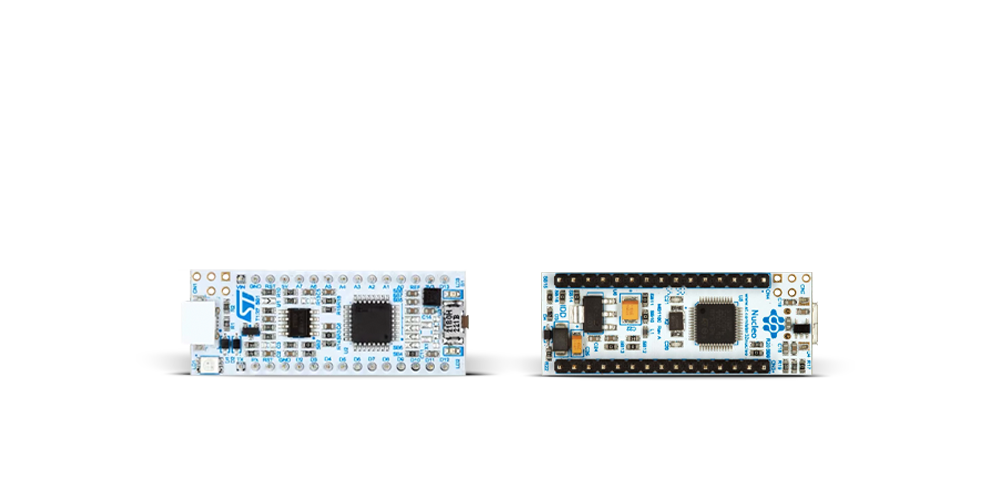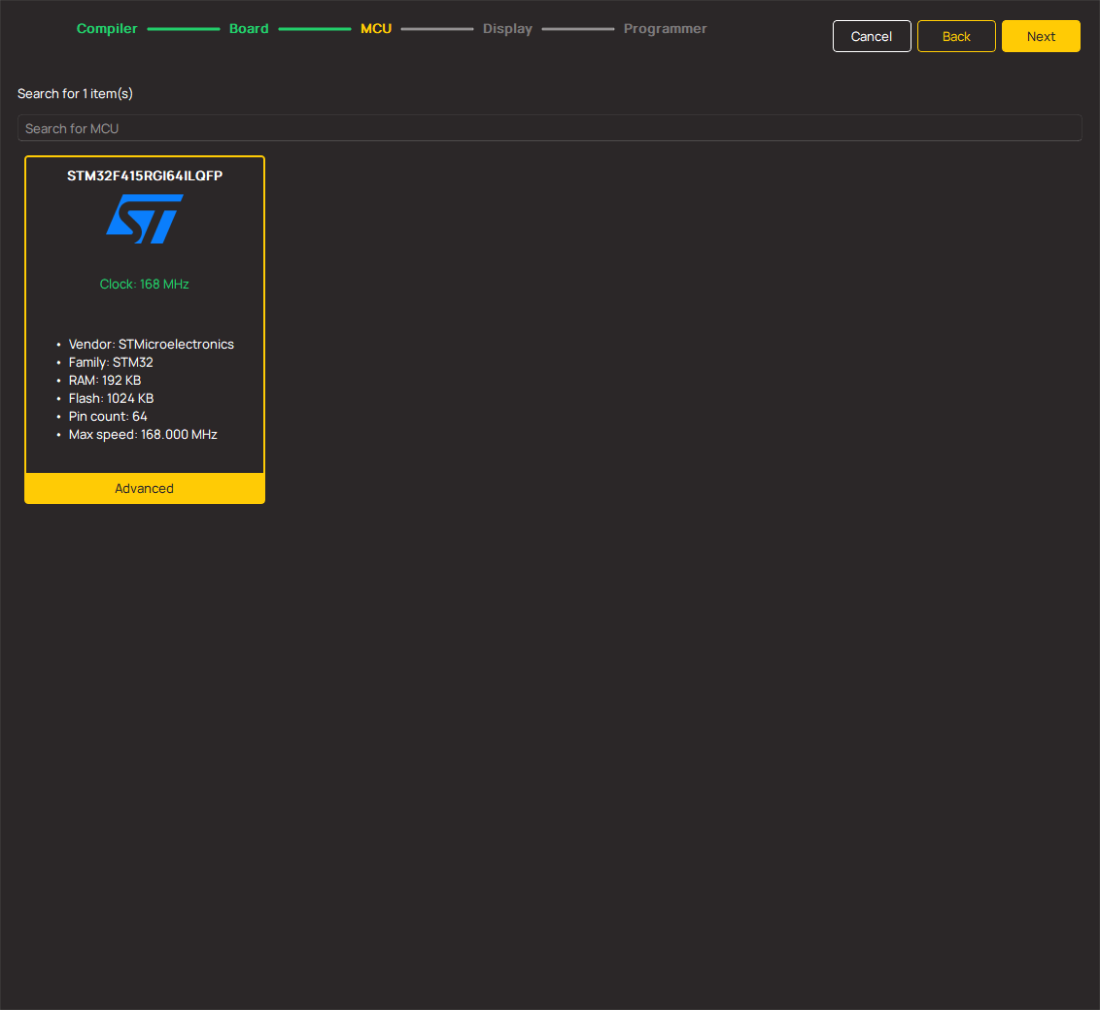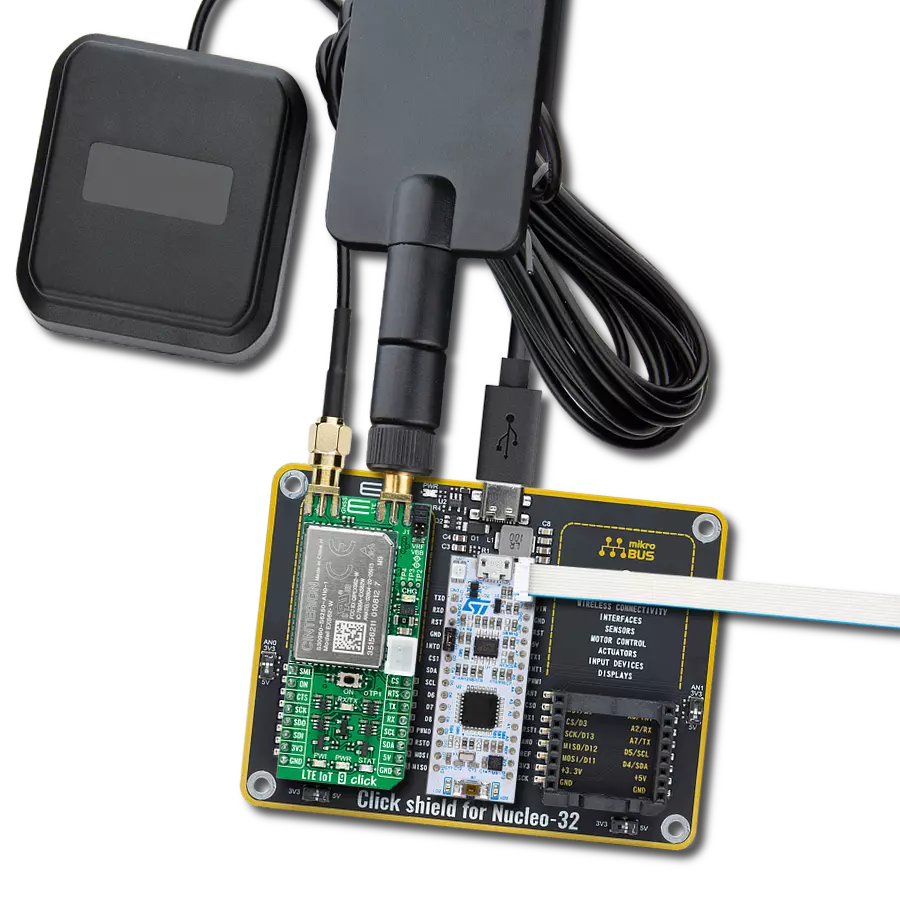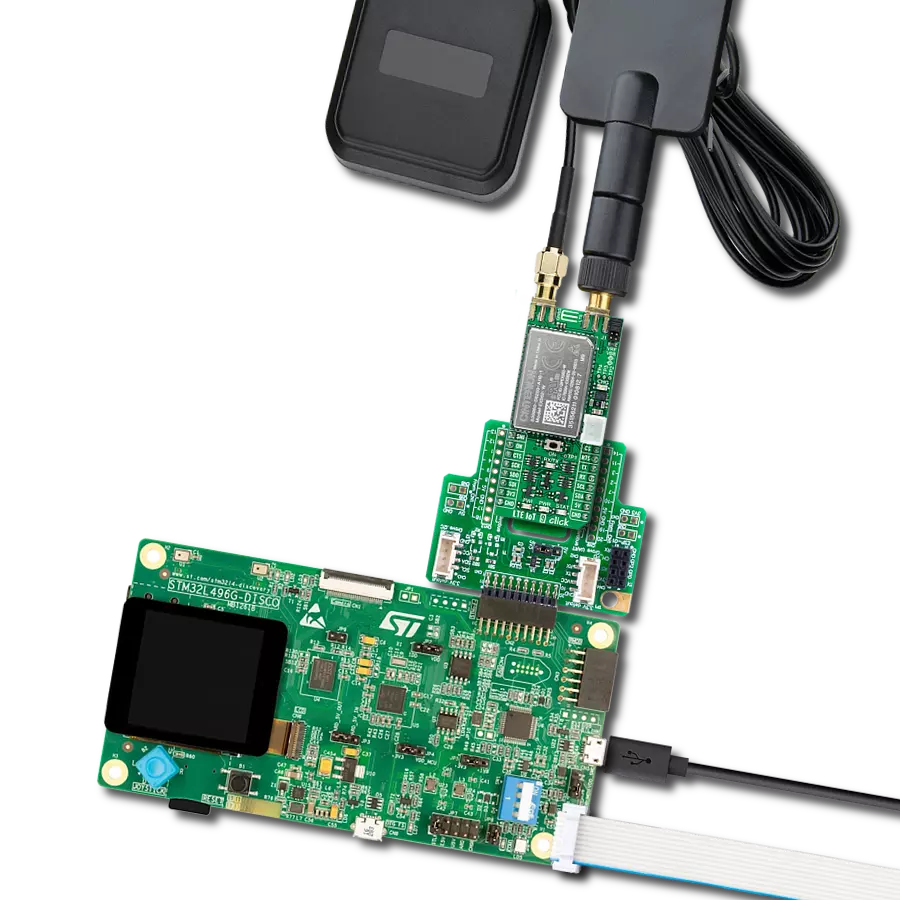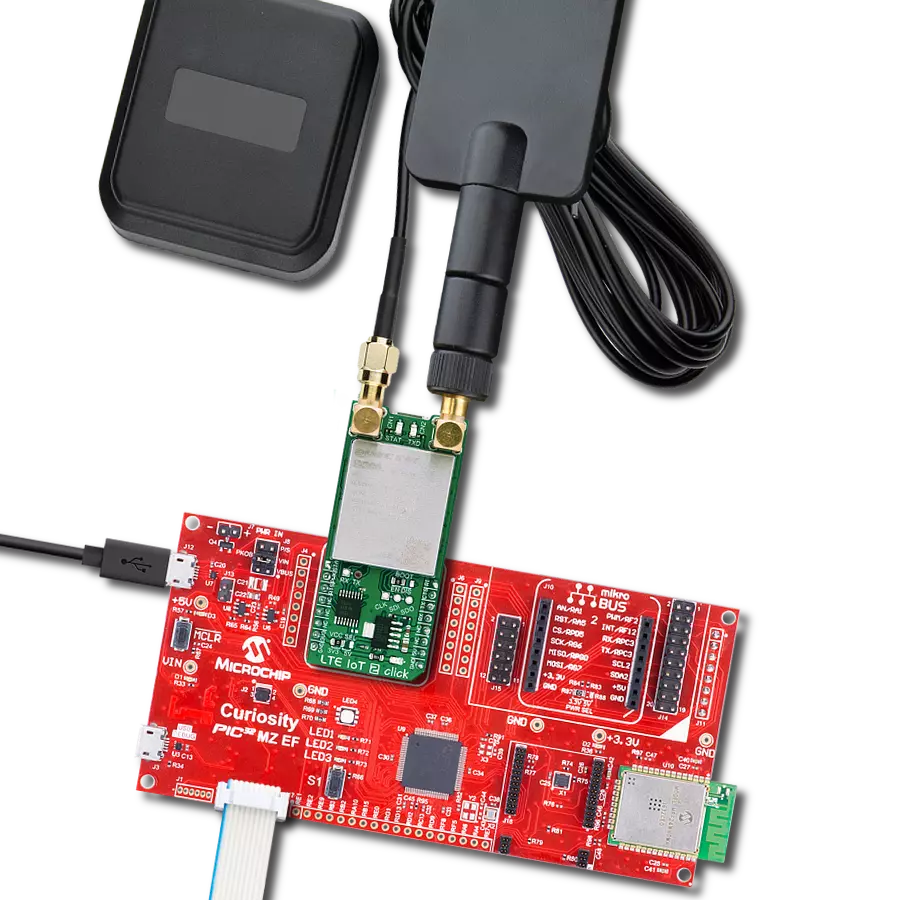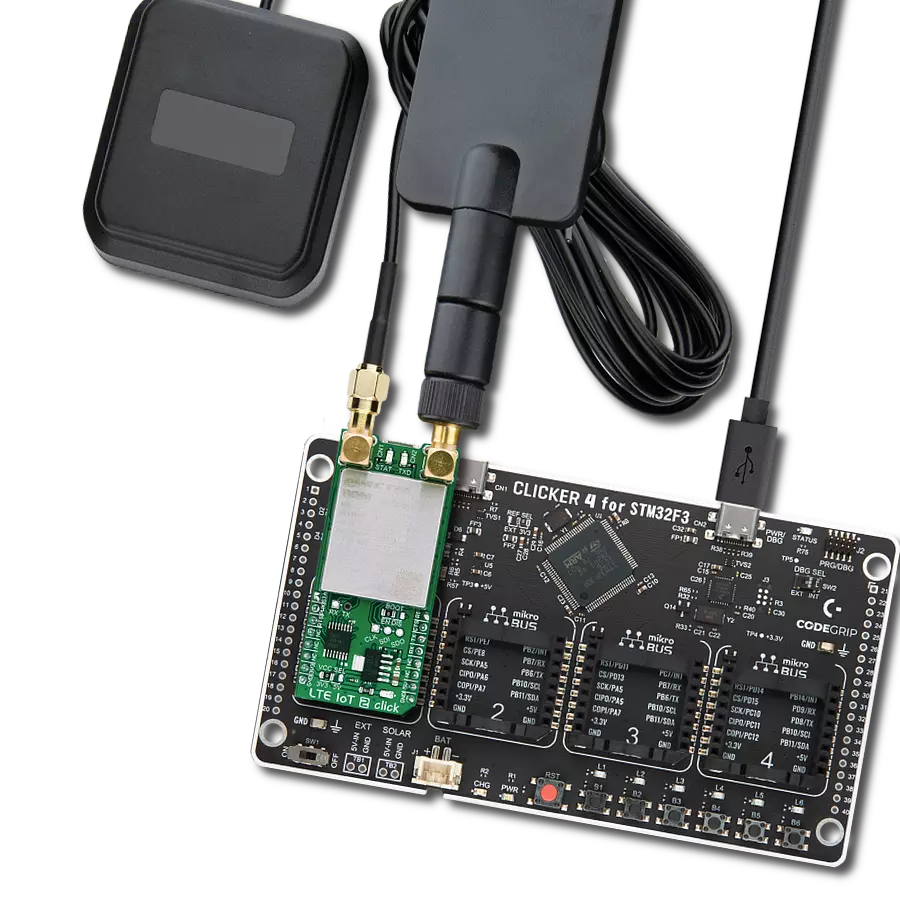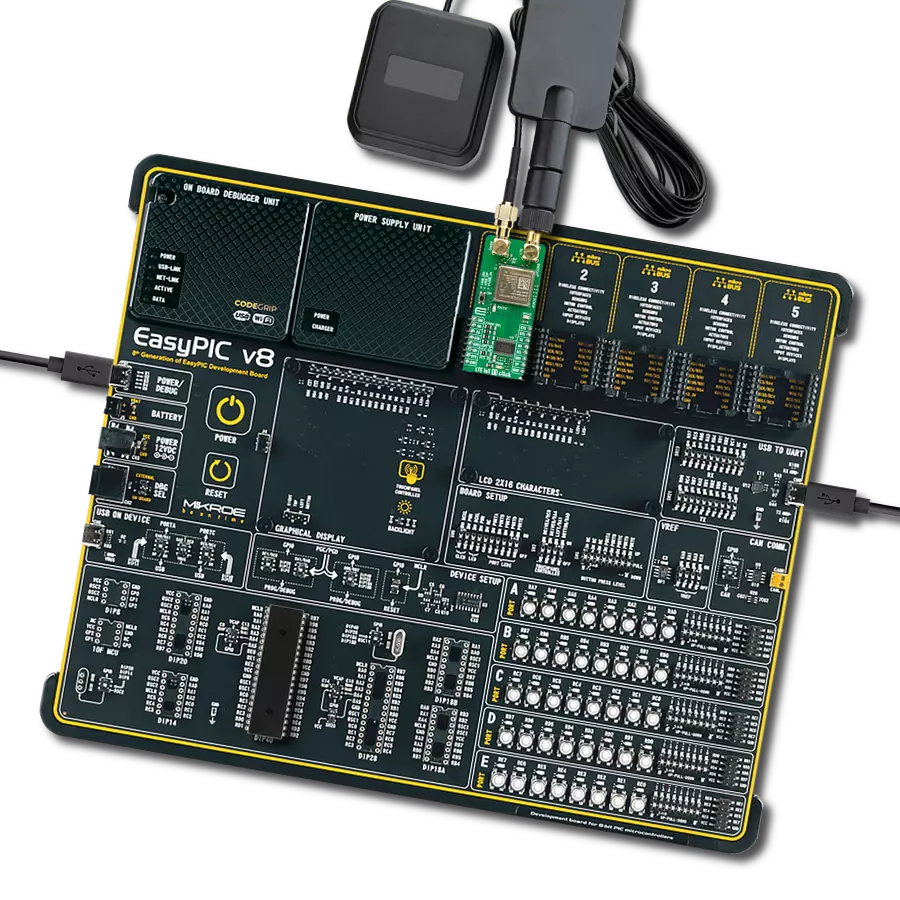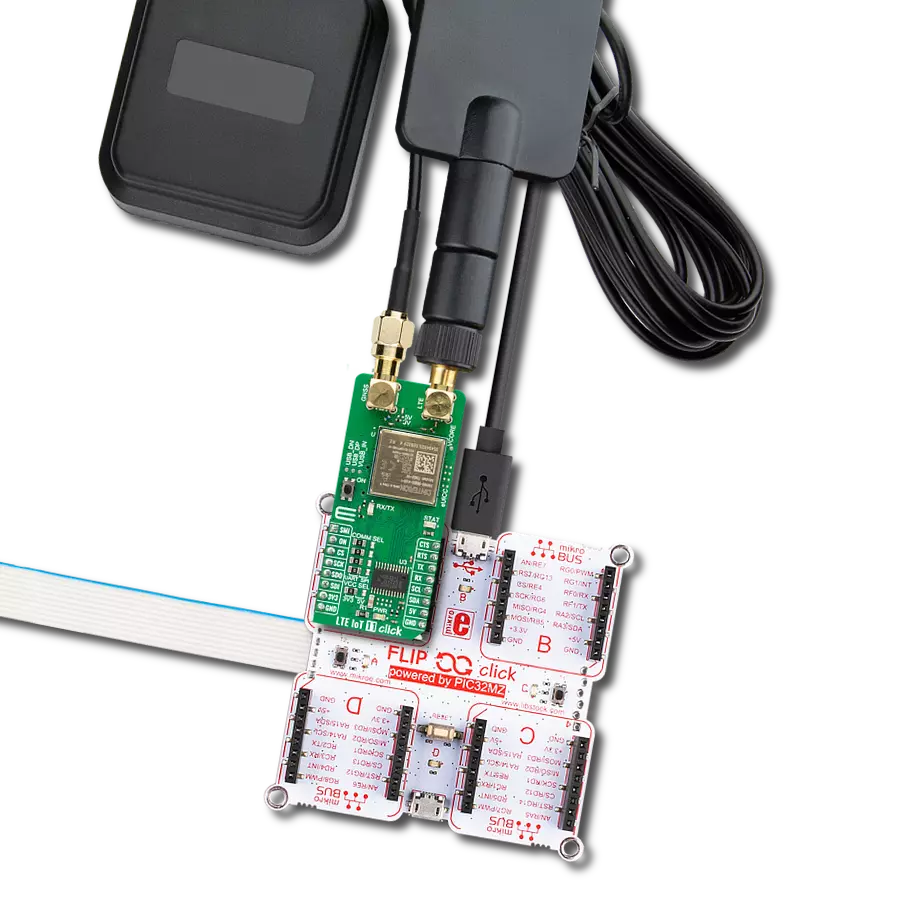Embrace smart solutions and smart connectivity with NB-IoT, opening up a world of possibilities to enhance your IoT applications
A
A
Hardware Overview
How does it work?
NB IoT 5 Click is based on the OT01-5, a high-performance narrow-band Internet of Things universal wireless communication module with extremely low power consumption, allowing a battery life of about ten years from Notion. It supports frequency bands worldwide, such as 1 / 2 / 3 / 5 / 8 / 19 / 20 of 3GPP R13 (NB1) and R14 (NB2). It also provides several interfaces, UART and SPI, and protocol stacks such as UDP/TCP, CoAP, LWM2M, and more. In addition to the motor driver inside design, these protocols allow data and SMS transfer using the NB technology, making this module a perfect choice for building IoT applications and smart gas and water meters without an external microcontroller unit. Two ways to turn on this Click board™: through the EN pin on the mikroBUS™ socket or pressing the PWRKEY button for longer than 3 seconds. The onboard push-button labeled as PWRKEY routed to the PWM pin on the mikroBUS™ socket represents the Ignition (Power-On) button.
This feature is shown by the yellow diode labeled STAT, which indicates the device's Operational Status. NB IoT 5 Click communicates with MCU using the UART interface as its default communication protocol with the option for the users to use another interface, such as SPI if they want to configure the module and write the library by themselves. It supports automatic baud rate detection, operates at 115200 bps by default configuration, and is used for data transmission and exchanging AT commands with the host MCU. Also, it has an additional header used for firmware upgrades, software debugging, log capturing, or even as a motor drive. In addition to these features, the OT01-5 uses several GPIO pins connected to the mikroBUS™ socket. The WUP pin routed on the AN pin of the mikroBUS™ represents the Wake-up function used for waking up the device, while the RST pin on the mikroBUS™ socket can perform a Hardware Reset function by putting this pin in a logic low state.
This Click board™ also has a micro USB connector, allowing the module to be powered and configured by a personal computer. NB IoT 5 Click possesses the SMA antenna connector with an impedance of 50Ω. This Click board™ can connect the appropriate antenna, such as the LTE Flat Rotation Antenna, that MIKROE offers. Besides the SMA connector, it has a Nano-SIM card slot that provides multiple connections and interface options. This Click board™ can operate with 3.3V and 5V MCUs set via a jumper labeled as VCC SEL with a proper logic voltage level conversion performed by the appropriate voltage level translator TXS0108E. This way, it allowed for both 3.3V and 5V capable MCUs to use communication lines properly. However, the Click board™ comes equipped with a library containing functions and an example code that can be used as a reference for further development.
Features overview
Development board
Nucleo 32 with STM32F031K6 MCU board provides an affordable and flexible platform for experimenting with STM32 microcontrollers in 32-pin packages. Featuring Arduino™ Nano connectivity, it allows easy expansion with specialized shields, while being mbed-enabled for seamless integration with online resources. The
board includes an on-board ST-LINK/V2-1 debugger/programmer, supporting USB reenumeration with three interfaces: Virtual Com port, mass storage, and debug port. It offers a flexible power supply through either USB VBUS or an external source. Additionally, it includes three LEDs (LD1 for USB communication, LD2 for power,
and LD3 as a user LED) and a reset push button. The STM32 Nucleo-32 board is supported by various Integrated Development Environments (IDEs) such as IAR™, Keil®, and GCC-based IDEs like AC6 SW4STM32, making it a versatile tool for developers.
Microcontroller Overview
MCU Card / MCU

Architecture
ARM Cortex-M0
MCU Memory (KB)
32
Silicon Vendor
STMicroelectronics
Pin count
32
RAM (Bytes)
4096
You complete me!
Accessories
Click Shield for Nucleo-32 is the perfect way to expand your development board's functionalities with STM32 Nucleo-32 pinout. The Click Shield for Nucleo-32 provides two mikroBUS™ sockets to add any functionality from our ever-growing range of Click boards™. We are fully stocked with everything, from sensors and WiFi transceivers to motor control and audio amplifiers. The Click Shield for Nucleo-32 is compatible with the STM32 Nucleo-32 board, providing an affordable and flexible way for users to try out new ideas and quickly create prototypes with any STM32 microcontrollers, choosing from the various combinations of performance, power consumption, and features. The STM32 Nucleo-32 boards do not require any separate probe as they integrate the ST-LINK/V2-1 debugger/programmer and come with the STM32 comprehensive software HAL library and various packaged software examples. This development platform provides users with an effortless and common way to combine the STM32 Nucleo-32 footprint compatible board with their favorite Click boards™ in their upcoming projects.
Used MCU Pins
mikroBUS™ mapper
Take a closer look
Click board™ Schematic

Step by step
Project assembly
Track your results in real time
Application Output
1. Application Output - In Debug mode, the 'Application Output' window enables real-time data monitoring, offering direct insight into execution results. Ensure proper data display by configuring the environment correctly using the provided tutorial.

2. UART Terminal - Use the UART Terminal to monitor data transmission via a USB to UART converter, allowing direct communication between the Click board™ and your development system. Configure the baud rate and other serial settings according to your project's requirements to ensure proper functionality. For step-by-step setup instructions, refer to the provided tutorial.

3. Plot Output - The Plot feature offers a powerful way to visualize real-time sensor data, enabling trend analysis, debugging, and comparison of multiple data points. To set it up correctly, follow the provided tutorial, which includes a step-by-step example of using the Plot feature to display Click board™ readings. To use the Plot feature in your code, use the function: plot(*insert_graph_name*, variable_name);. This is a general format, and it is up to the user to replace 'insert_graph_name' with the actual graph name and 'variable_name' with the parameter to be displayed.

Software Support
Library Description
NB IoT 5 Click demo application is developed using the NECTO Studio, ensuring compatibility with mikroSDK's open-source libraries and tools. Designed for plug-and-play implementation and testing, the demo is fully compatible with all development, starter, and mikromedia boards featuring a mikroBUS™ socket.
Example Description
Application example shows device capability of connecting to the network and sending SMS or TCP/UDP messages using standard "AT" commands.
Key functions:
nbiot5_cfg_setup- Config Object Initialization function.nbiot5_init- Initialization function.nbiot5_set_sim_apn- This function sets APN for sim card.nbiot5_send_sms_text- This function sends text message to a phone number.nbiot5_send_sms_pdu- This function sends text message to a phone number in PDU mode.
Application Init
Initializes the driver, tests the communication by sending "AT" command, and after that restarts the device.
Application Task
Application task is split in few stages:
NBIOT5_CONFIGURE_FOR_NETWORK:Sets configuration to device to be able to connect to the network.NBIOT5_WAIT_FOR_CONNECTION:Waits for the network registration indicated via CEREG URC event and then checks the connection status.NBIOT5_CONFIGURE_FOR_EXAMPLE:Sets the device configuration for sending SMS or TCP/UDP messages depending on the selected demo example.NBIOT5_EXAMPLE:Depending on the selected demo example, it sends an SMS message (in PDU or TXT mode) or TCP/UDP message. By default, the TCP/UDP example is selected.
Open Source
Code example
The complete application code and a ready-to-use project are available through the NECTO Studio Package Manager for direct installation in the NECTO Studio. The application code can also be found on the MIKROE GitHub account.
/*!
* @file main.c
* @brief NB IoT 5 Click Example.
*
* # Description
* Application example shows device capability of connecting to the network and
* sending SMS or TCP/UDP messages using standard "AT" commands.
*
* The demo application is composed of two sections :
*
* ## Application Init
* Initializes the driver, tests the communication by sending "AT" command, and after that restarts the device.
*
* ## Application Task
* Application task is split in few stages:
* - NBIOT5_CONFIGURE_FOR_NETWORK:
* Sets configuration to device to be able to connect to the network.
*
* - NBIOT5_WAIT_FOR_CONNECTION:
* Waits for the network registration indicated via CEREG URC event and then checks
* the connection status.
*
* - NBIOT5_CONFIGURE_FOR_EXAMPLE:
* Sets the device configuration for sending SMS or TCP/UDP messages depending on the selected demo example.
*
* - NBIOT5_EXAMPLE:
* Depending on the selected demo example, it sends an SMS message (in PDU or TXT mode) or TCP/UDP message.
*
* By default, the TCP/UDP example is selected.
*
* ## Additional Function
* - static void nbiot5_clear_app_buf ( void )
* - static err_t nbiot5_process ( void )
* - static void nbiot5_error_check( err_t error_flag )
* - static void nbiot5_log_app_buf ( void )
* - static err_t nbiot5_rsp_check ( uint8_t *rsp )
* - static err_t nbiot5_configure_for_connection( void )
* - static err_t nbiot5_check_connection( void )
* - static err_t nbiot5_configure_for_messages( void )
* - static err_t nbiot5_send_message( void )
*
* @note
* In order for the examples to work, user needs to set the APN and SMSC (SMS PDU mode only)
* of entered SIM card as well as the phone number (SMS mode only) to which he wants to send an SMS.
* Enter valid values for the following macros: SIM_APN, SIM_SMSC and PHONE_NUMBER_TO_MESSAGE.
* Example:
SIM_APN "internet"
SIM_SMSC "+381610401"
PHONE_NUMBER_TO_MESSAGE "+381659999999"
* Make sure the JP2 is removed from the Click board, otherwise, you will need to connect the USB
* so that the module can boot up successfully.
*
* @author Stefan Filipovic
*
*/
#include "board.h"
#include "log.h"
#include "nbiot5.h"
#include "conversions.h"
// Example selection macros
#define EXAMPLE_TCP_UDP 0 // Example of sending messages to a TCP/UDP echo server
#define EXAMPLE_SMS 1 // Example of sending SMS to a phone number
#define DEMO_EXAMPLE EXAMPLE_TCP_UDP // Example selection macro
// SIM APN config
#define SIM_APN "internet" // Set valid SIM APN
// SMS example parameters
#define SIM_SMSC "" // Set valid SMS Service Center Address - only in SMS PDU mode
#define PHONE_NUMBER_TO_MESSAGE "" // Set Phone number to message
#define SMS_MODE "1" // SMS mode: "0" - PDU, "1" - TXT
// TCP/UDP example parameters
#define REMOTE_IP "77.46.162.162" // TCP/UDP echo server IP address
#define REMOTE_PORT "51111" // TCP/UDP echo server port
// Message content
#define MESSAGE_CONTENT "NB IoT 5 Click board - demo example."
// Application buffer size
#define APP_BUFFER_SIZE 256
#define PROCESS_BUFFER_SIZE 256
/**
* @brief Example states.
* @details Predefined enum values for application example state.
*/
typedef enum
{
NBIOT5_CONFIGURE_FOR_NETWORK = 1,
NBIOT5_WAIT_FOR_CONNECTION,
NBIOT5_CONFIGURE_FOR_EXAMPLE,
NBIOT5_EXAMPLE
} nbiot5_example_state_t;
static nbiot5_t nbiot5;
static log_t logger;
/**
* @brief Application example variables.
* @details Variables used in application example.
*/
static uint8_t app_buf[ APP_BUFFER_SIZE ] = { 0 };
static int32_t app_buf_len = 0;
static err_t error_flag;
static nbiot5_example_state_t example_state;
/**
* @brief Clearing application buffer.
* @details This function clears memory of application
* buffer and reset its length and counter.
*/
static void nbiot5_clear_app_buf ( void );
/**
* @brief Data reading function.
* @details This function reads data from device and
* appends it to the application buffer.
* @return @li @c 0 - Some data is read.
* @li @c -1 - Nothing is read.
* See #err_t definition for detailed explanation.
*/
static err_t nbiot5_process ( void );
/**
* @brief Check for errors.
* @details This function checks for different types of
* errors and logs them on UART or logs the response if no errors occured.
* @param[in] error_flag Error flag to check.
*/
static void nbiot5_error_check ( err_t error_flag );
/**
* @brief Logs application buffer.
* @details This function logs data from application buffer.
*/
static void nbiot5_log_app_buf ( void );
/**
* @brief Response check.
* @details This function checks for response and
* returns the status of response.
* @param[in] rsp Expected response.
* @return @li @c 0 - OK response.
* @li @c -2 - Timeout error.
* @li @c -3 - Command error.
* @li @c -4 - Unknown error.
* See #err_t definition for detailed explanation.
*/
static err_t nbiot5_rsp_check ( uint8_t *rsp );
/**
* @brief Configure device for connection to the network.
* @details Sends commands to configure and enable
* connection to the specified network.
* @return @li @c 0 - OK response.
* @li @c -2 - Timeout error.
* @li @c -3 - Command error.
* @li @c -4 - Unknown error.
* See #err_t definition for detailed explanation.
*/
static err_t nbiot5_configure_for_network ( void );
/**
* @brief Wait for connection signal.
* @details Wait for connection signal from CREG URC.
* @return @li @c 0 - OK response.
* @li @c -2 - Timeout error.
* @li @c -3 - Command error.
* @li @c -4 - Unknown error.
* See #err_t definition for detailed explanation.
*/
static err_t nbiot5_check_connection ( void );
/**
* @brief Configure device for example.
* @details Configure device for the specified example.
* @return @li @c 0 - OK response.
* @li @c -2 - Timeout error.
* @li @c -3 - Command error.
* @li @c -4 - Unknown error.
* See #err_t definition for detailed explanation.
*/
static err_t nbiot5_configure_for_example ( void );
/**
* @brief Execute example.
* @details This function executes SMS or TCP/UDP example depending on the DEMO_EXAMPLE macro.
* @return @li @c 0 - OK response.
* @li @c -2 - Timeout error.
* @li @c -3 - Command error.
* @li @c -4 - Unknown error.
* See #err_t definition for detailed explanation.
*/
static err_t nbiot5_example ( void );
void application_init ( void )
{
log_cfg_t log_cfg; /**< Logger config object. */
nbiot5_cfg_t nbiot5_cfg; /**< Click config object. */
/**
* Logger initialization.
* Default baud rate: 115200
* Default log level: LOG_LEVEL_DEBUG
* @note If USB_UART_RX and USB_UART_TX
* are defined as HAL_PIN_NC, you will
* need to define them manually for log to work.
* See @b LOG_MAP_USB_UART macro definition for detailed explanation.
*/
LOG_MAP_USB_UART( log_cfg );
log_init( &logger, &log_cfg );
log_info( &logger, " Application Init " );
// Click initialization.
nbiot5_cfg_setup( &nbiot5_cfg );
NBIOT5_MAP_MIKROBUS( nbiot5_cfg, MIKROBUS_1 );
if ( UART_ERROR == nbiot5_init( &nbiot5, &nbiot5_cfg ) )
{
log_error( &logger, " Application Init Error. " );
log_info( &logger, " Please, run program again... " );
for ( ; ; );
}
nbiot5_process( );
nbiot5_clear_app_buf( );
// Check communication
nbiot5_send_cmd( &nbiot5, NBIOT5_CMD_AT );
error_flag = nbiot5_rsp_check( NBIOT5_RSP_OK );
nbiot5_error_check( error_flag );
// Restart device
#define RESTART_DEVICE "1,1"
nbiot5_send_cmd_with_par( &nbiot5, NBIOT5_CMD_CFUN, RESTART_DEVICE );
error_flag = nbiot5_rsp_check( NBIOT5_RSP_OK );
nbiot5_error_check( error_flag );
log_info( &logger, " Application Task " );
example_state = NBIOT5_CONFIGURE_FOR_NETWORK;
}
void application_task ( void )
{
switch ( example_state )
{
case NBIOT5_CONFIGURE_FOR_NETWORK:
{
if ( NBIOT5_OK == nbiot5_configure_for_network( ) )
{
example_state = NBIOT5_WAIT_FOR_CONNECTION;
}
break;
}
case NBIOT5_WAIT_FOR_CONNECTION:
{
if ( NBIOT5_OK == nbiot5_check_connection( ) )
{
example_state = NBIOT5_CONFIGURE_FOR_EXAMPLE;
}
break;
}
case NBIOT5_CONFIGURE_FOR_EXAMPLE:
{
if ( NBIOT5_OK == nbiot5_configure_for_example( ) )
{
example_state = NBIOT5_EXAMPLE;
}
break;
}
case NBIOT5_EXAMPLE:
{
nbiot5_example( );
break;
}
default:
{
log_error( &logger, " Example state." );
break;
}
}
}
int main ( void )
{
/* Do not remove this line or clock might not be set correctly. */
#ifdef PREINIT_SUPPORTED
preinit();
#endif
application_init( );
for ( ; ; )
{
application_task( );
}
return 0;
}
static void nbiot5_clear_app_buf ( void )
{
memset( app_buf, 0, app_buf_len );
app_buf_len = 0;
}
static err_t nbiot5_process ( void )
{
uint8_t rx_buf[ PROCESS_BUFFER_SIZE ] = { 0 };
int32_t rx_size = 0;
rx_size = nbiot5_generic_read( &nbiot5, rx_buf, PROCESS_BUFFER_SIZE );
if ( rx_size > 0 )
{
int32_t buf_cnt = app_buf_len;
if ( ( ( app_buf_len + rx_size ) > APP_BUFFER_SIZE ) && ( app_buf_len > 0 ) )
{
buf_cnt = APP_BUFFER_SIZE - ( ( app_buf_len + rx_size ) - APP_BUFFER_SIZE );
memmove ( app_buf, &app_buf[ APP_BUFFER_SIZE - buf_cnt ], buf_cnt );
}
for ( int32_t rx_cnt = 0; rx_cnt < rx_size; rx_cnt++ )
{
if ( rx_buf[ rx_cnt ] )
{
app_buf[ buf_cnt++ ] = rx_buf[ rx_cnt ];
if ( app_buf_len < APP_BUFFER_SIZE )
{
app_buf_len++;
}
}
}
return NBIOT5_OK;
}
return NBIOT5_ERROR;
}
static err_t nbiot5_rsp_check ( uint8_t *rsp )
{
uint32_t timeout_cnt = 0;
uint32_t timeout = 120000;
nbiot5_clear_app_buf( );
nbiot5_process( );
while ( ( 0 == strstr( app_buf, rsp ) ) &&
( 0 == strstr( app_buf, NBIOT5_RSP_ERROR ) ) )
{
nbiot5_process( );
if ( timeout_cnt++ > timeout )
{
nbiot5_clear_app_buf( );
return NBIOT5_ERROR_TIMEOUT;
}
Delay_ms ( 1 );
}
Delay_ms ( 100 );
nbiot5_process( );
if ( strstr( app_buf, rsp ) )
{
return NBIOT5_OK;
}
else if ( strstr( app_buf, NBIOT5_RSP_ERROR ) )
{
return NBIOT5_ERROR_CMD;
}
else
{
return NBIOT5_ERROR_UNKNOWN;
}
}
static void nbiot5_error_check ( err_t error_flag )
{
switch ( error_flag )
{
case NBIOT5_OK:
{
nbiot5_log_app_buf( );
break;
}
case NBIOT5_ERROR:
{
log_error( &logger, " Overflow!" );
break;
}
case NBIOT5_ERROR_TIMEOUT:
{
log_error( &logger, " Timeout!" );
break;
}
case NBIOT5_ERROR_CMD:
{
log_error( &logger, " CMD!" );
break;
}
case NBIOT5_ERROR_UNKNOWN:
default:
{
log_error( &logger, " Unknown!" );
break;
}
}
Delay_ms ( 500 );
}
static void nbiot5_log_app_buf ( void )
{
for ( int32_t buf_cnt = 0; buf_cnt < app_buf_len; buf_cnt++ )
{
log_printf( &logger, "%c", app_buf[ buf_cnt ] );
}
}
static err_t nbiot5_configure_for_network ( void )
{
err_t func_error = NBIOT5_OK;
#if ( ( DEMO_EXAMPLE == EXAMPLE_TCP_UDP ) || ( DEMO_EXAMPLE == EXAMPLE_SMS ) )
Delay_ms ( 1000 );
Delay_ms ( 1000 );
Delay_ms ( 1000 );
Delay_ms ( 1000 );
Delay_ms ( 1000 );
// Deregister from network
#define DEREGISTER_FROM_NETWORK "2"
nbiot5_send_cmd_with_par( &nbiot5, NBIOT5_CMD_COPS, DEREGISTER_FROM_NETWORK );
error_flag = nbiot5_rsp_check( NBIOT5_RSP_OK );
func_error |= error_flag;
nbiot5_error_check( error_flag );
// Set SIM APN
nbiot5_set_sim_apn( &nbiot5, SIM_APN );
error_flag = nbiot5_rsp_check( NBIOT5_RSP_OK );
func_error |= error_flag;
nbiot5_error_check( error_flag );
// Enable full functionality
#define FULL_FUNCTIONALITY "1"
nbiot5_send_cmd_with_par( &nbiot5, NBIOT5_CMD_CFUN, FULL_FUNCTIONALITY );
error_flag = nbiot5_rsp_check( NBIOT5_RSP_OK );
func_error |= error_flag;
nbiot5_error_check( error_flag );
#define ENABLE_EPS_REG "2"
nbiot5_send_cmd_with_par( &nbiot5, NBIOT5_CMD_CEREG, ENABLE_EPS_REG );
error_flag = nbiot5_rsp_check( NBIOT5_RSP_OK );
func_error |= error_flag;
nbiot5_error_check( error_flag );
// Automatic registration
#define AUTOMATIC_REGISTRATION "0"
nbiot5_send_cmd_with_par( &nbiot5, NBIOT5_CMD_COPS, AUTOMATIC_REGISTRATION );
error_flag = nbiot5_rsp_check( NBIOT5_RSP_OK );
func_error |= error_flag;
nbiot5_error_check( error_flag );
#endif
return func_error;
}
static err_t nbiot5_check_connection ( void )
{
#if ( ( DEMO_EXAMPLE == EXAMPLE_TCP_UDP ) || ( DEMO_EXAMPLE == EXAMPLE_SMS ) )
#define CONNECTED "+CEREG: 2,1"
nbiot5_send_cmd_check ( &nbiot5, NBIOT5_CMD_CEREG );
error_flag = nbiot5_rsp_check( NBIOT5_RSP_OK );
nbiot5_error_check( error_flag );
if ( strstr( app_buf, CONNECTED ) )
{
Delay_ms ( 100 );
// Check signal quality
nbiot5_send_cmd( &nbiot5, NBIOT5_CMD_CSQ );
error_flag = nbiot5_rsp_check( NBIOT5_RSP_OK );
nbiot5_error_check( error_flag );
#define NO_SIGNAL "99,99"
if ( !strstr( app_buf, NO_SIGNAL ) )
{
Delay_ms ( 1000 );
return error_flag;
}
}
Delay_ms ( 1000 );
return NBIOT5_ERROR;
#endif
return NBIOT5_OK;
}
static err_t nbiot5_configure_for_example ( void )
{
err_t func_error = NBIOT5_OK;
#if ( DEMO_EXAMPLE == EXAMPLE_TCP_UDP )
Delay_ms ( 1000 );
Delay_ms ( 1000 );
Delay_ms ( 1000 );
Delay_ms ( 1000 );
Delay_ms ( 1000 );
#elif ( DEMO_EXAMPLE == EXAMPLE_SMS )
nbiot5_send_cmd_with_par( &nbiot5, NBIOT5_CMD_CMGF, SMS_MODE );
error_flag = nbiot5_rsp_check( NBIOT5_RSP_OK );
func_error |= error_flag;
nbiot5_error_check( error_flag );
#else
#error "No demo example selected"
#endif
return func_error;
}
static err_t nbiot5_example ( void )
{
err_t func_error = NBIOT5_OK;
#if ( DEMO_EXAMPLE == EXAMPLE_TCP_UDP )
uint8_t cmd_buf[ 100 ] = { 0 };
uint8_t * __generic_ptr socket_num_buf = 0;
uint8_t tcp_socket_num[ 2 ] = { 0 };
uint8_t udp_socket_num[ 2 ] = { 0 };
// Create TCP socket.
#define RESPONSE_ESOC "\r\n+ESOC="
#define TCP_PROTOCOL "1,1,1"
nbiot5_send_cmd_with_par( &nbiot5, NBIOT5_CMD_ESOC, TCP_PROTOCOL );
error_flag = nbiot5_rsp_check( NBIOT5_RSP_OK );
func_error |= error_flag;
nbiot5_error_check( error_flag );
socket_num_buf = strstr( app_buf, RESPONSE_ESOC ) + strlen ( RESPONSE_ESOC );
tcp_socket_num[ 0 ] = *socket_num_buf;
// Create UDP socket.
#define UDP_PROTOCOL "1,2,1"
nbiot5_send_cmd_with_par( &nbiot5, NBIOT5_CMD_ESOC, UDP_PROTOCOL );
error_flag = nbiot5_rsp_check( NBIOT5_RSP_OK );
func_error |= error_flag;
nbiot5_error_check( error_flag );
socket_num_buf = strstr( app_buf, RESPONSE_ESOC ) + strlen ( RESPONSE_ESOC );
udp_socket_num[ 0 ] = *socket_num_buf;
// Connect TCP socket to remote IP and port
strcpy( cmd_buf, tcp_socket_num );
strcat( cmd_buf, "," );
strcat( cmd_buf, REMOTE_PORT );
strcat( cmd_buf, ",\"" );
strcat( cmd_buf, REMOTE_IP );
strcat( cmd_buf, "\"" );
nbiot5_send_cmd_with_par( &nbiot5, NBIOT5_CMD_ESOCON, cmd_buf );
error_flag = nbiot5_rsp_check( NBIOT5_RSP_OK );
func_error |= error_flag;
nbiot5_error_check( error_flag );
// Connect UDP socket to remote IP and port
strcpy( cmd_buf, udp_socket_num );
strcat( cmd_buf, "," );
strcat( cmd_buf, REMOTE_PORT );
strcat( cmd_buf, ",\"" );
strcat( cmd_buf, REMOTE_IP );
strcat( cmd_buf, "\"" );
nbiot5_send_cmd_with_par( &nbiot5, NBIOT5_CMD_ESOCON, cmd_buf );
error_flag = nbiot5_rsp_check( NBIOT5_RSP_OK );
func_error |= error_flag;
nbiot5_error_check( error_flag );
// Get message length
uint8_t message_len_buf[ 5 ] = { 0 };
uint16_t message_len = strlen( MESSAGE_CONTENT );
uint16_to_str( message_len, message_len_buf );
l_trim( message_len_buf );
r_trim( message_len_buf );
// Write message to TCP socket
uint8_t byte_buf[ 5 ] = { 0 };
strcpy( cmd_buf, tcp_socket_num );
strcat( cmd_buf, "," );
strcat( cmd_buf, message_len_buf );
strcat( cmd_buf, "," );
for ( uint16_t cnt = 0; cnt < message_len; cnt++ )
{
uint8_to_hex ( MESSAGE_CONTENT[ cnt ], byte_buf );
strcat ( cmd_buf, byte_buf );
}
nbiot5_send_cmd_with_par( &nbiot5, NBIOT5_CMD_ESOSEND, cmd_buf );
error_flag = nbiot5_rsp_check( NBIOT5_RSP_OK );
func_error |= error_flag;
nbiot5_error_check( error_flag );
// Read response
#define RESPONSE_URC "+ESONMI"
error_flag = nbiot5_rsp_check( RESPONSE_URC );
func_error |= error_flag;
nbiot5_error_check( error_flag );
// Parse response
uint8_t response[ 100 ] = { 0 };
uint8_t response_len[ 5 ] = { 0 };
char * __generic_ptr start_response_len_buf = 0;
uint8_t response_len_buf_len = 0;
start_response_len_buf = strstr( app_buf, RESPONSE_URC ) + 10;
response_len_buf_len = strstr( start_response_len_buf, "," ) - start_response_len_buf;
memcpy ( response_len, start_response_len_buf, response_len_buf_len );
memcpy ( response, start_response_len_buf + 3, atoi( response_len ) * 2 );
for ( uint8_t cnt = 0; cnt < atoi( response_len ); cnt++ )
{
response[ cnt ] = hex_to_uint8 ( &response[ cnt * 2 ] );
}
response[ atoi( response_len ) ] = 0;
log_printf( &logger, "Response: %s\r\n", response );
// Write message to UDP socket
strcpy( cmd_buf, udp_socket_num );
strcat( cmd_buf, "," );
strcat( cmd_buf, message_len_buf );
strcat( cmd_buf, "," );
for ( uint16_t cnt = 0; cnt < message_len; cnt++ )
{
uint8_to_hex ( MESSAGE_CONTENT[ cnt ], byte_buf );
strcat ( cmd_buf, byte_buf );
}
nbiot5_send_cmd_with_par( &nbiot5, NBIOT5_CMD_ESOSEND, cmd_buf );
error_flag = nbiot5_rsp_check( NBIOT5_RSP_OK );
func_error |= error_flag;
nbiot5_error_check( error_flag );
// Read response
#define RESPONSE_URC "+ESONMI"
error_flag = nbiot5_rsp_check( RESPONSE_URC );
func_error |= error_flag;
nbiot5_error_check( error_flag );
// Parse response
start_response_len_buf = strstr( app_buf, RESPONSE_URC ) + 10;
response_len_buf_len = strstr( start_response_len_buf, "," ) - start_response_len_buf;
memcpy ( response_len, start_response_len_buf, response_len_buf_len );
memcpy ( response, start_response_len_buf + 3, atoi( response_len ) * 2 );
for ( uint8_t cnt = 0; cnt < atoi( response_len ); cnt++ )
{
response[ cnt ] = hex_to_uint8 ( &response[ cnt * 2 ] );
}
response[ atoi( response_len ) ] = 0;
log_printf( &logger, "Response: %s\r\n", response );
// Close TCP socket
nbiot5_send_cmd_with_par( &nbiot5, NBIOT5_CMD_ESOCL, tcp_socket_num );
error_flag = nbiot5_rsp_check( NBIOT5_RSP_OK );
func_error |= error_flag;
nbiot5_error_check( error_flag );
// Close UDP socket
nbiot5_send_cmd_with_par( &nbiot5, NBIOT5_CMD_ESOCL, udp_socket_num );
error_flag = nbiot5_rsp_check( NBIOT5_RSP_OK );
func_error |= error_flag;
nbiot5_error_check( error_flag );
Delay_ms ( 1000 );
Delay_ms ( 1000 );
Delay_ms ( 1000 );
Delay_ms ( 1000 );
Delay_ms ( 1000 );
#elif ( DEMO_EXAMPLE == EXAMPLE_SMS )
// Check SMS mode
#define CMGF_PDU "+CMGF: 0"
#define CMGF_TXT "+CMGF: 1"
nbiot5_send_cmd_check( &nbiot5, NBIOT5_CMD_CMGF );
error_flag = nbiot5_rsp_check( NBIOT5_RSP_OK );
func_error |= error_flag;
nbiot5_error_check( error_flag );
if ( strstr( app_buf, CMGF_PDU ) )
{
// Send SMS in PDU mode
nbiot5_send_sms_pdu( &nbiot5, SIM_SMSC, PHONE_NUMBER_TO_MESSAGE, MESSAGE_CONTENT );
error_flag = nbiot5_rsp_check( NBIOT5_RSP_OK );
func_error |= error_flag;
nbiot5_error_check( error_flag );
}
else if ( strstr( app_buf, CMGF_TXT ) )
{
// Send SMS in TXT mode
nbiot5_send_sms_text ( &nbiot5, PHONE_NUMBER_TO_MESSAGE, MESSAGE_CONTENT );
error_flag = nbiot5_rsp_check( NBIOT5_RSP_OK );
func_error |= error_flag;
nbiot5_error_check( error_flag );
}
// 30 seconds delay
Delay_ms ( 1000 );
Delay_ms ( 1000 );
Delay_ms ( 1000 );
Delay_ms ( 1000 );
Delay_ms ( 1000 );
Delay_ms ( 1000 );
Delay_ms ( 1000 );
Delay_ms ( 1000 );
Delay_ms ( 1000 );
Delay_ms ( 1000 );
Delay_ms ( 1000 );
Delay_ms ( 1000 );
Delay_ms ( 1000 );
Delay_ms ( 1000 );
Delay_ms ( 1000 );
Delay_ms ( 1000 );
Delay_ms ( 1000 );
Delay_ms ( 1000 );
Delay_ms ( 1000 );
Delay_ms ( 1000 );
Delay_ms ( 1000 );
Delay_ms ( 1000 );
Delay_ms ( 1000 );
Delay_ms ( 1000 );
Delay_ms ( 1000 );
Delay_ms ( 1000 );
Delay_ms ( 1000 );
Delay_ms ( 1000 );
Delay_ms ( 1000 );
Delay_ms ( 1000 );
#else
#error "No demo example selected"
#endif
return func_error;
}
// ------------------------------------------------------------------------ END
Additional Support
Resources
Category:LTE IoT


